ignition JEEP WRANGLER UNLIMITED 2021 Owner handbook (in English)
[x] Cancel search | Manufacturer: JEEP, Model Year: 2021, Model line: WRANGLER UNLIMITED, Model: JEEP WRANGLER UNLIMITED 2021Pages: 330, PDF Size: 9.16 MB
Page 107 of 330
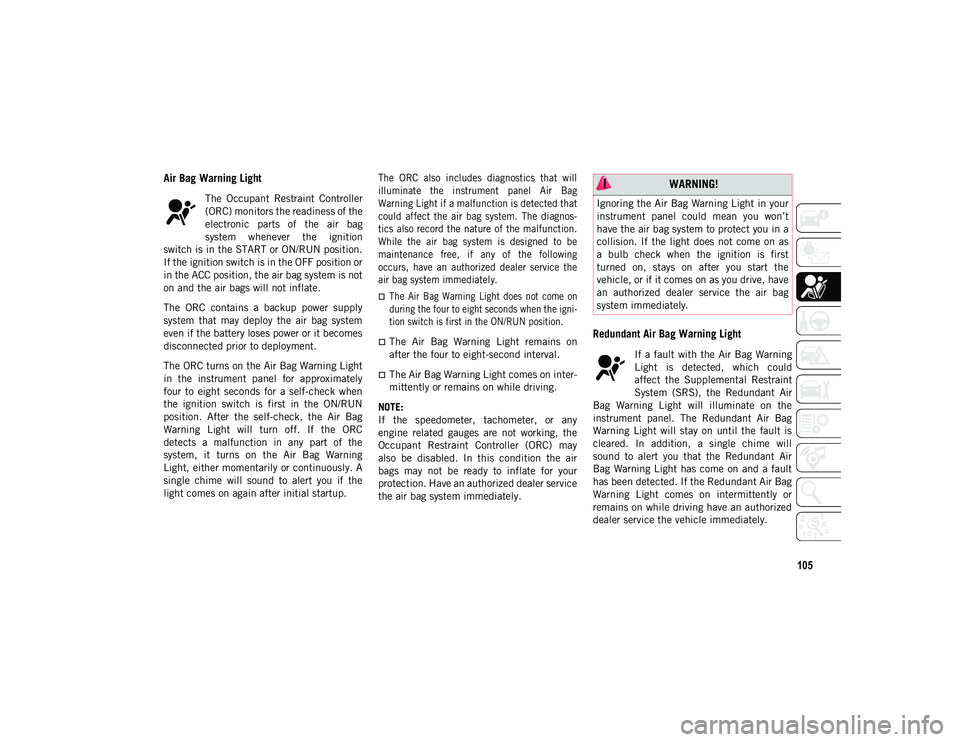
105
Air Bag Warning Light
The Occupant Restraint Controller
(ORC) monitors the readiness of the
electronic parts of the air bag
system whenever the ignition
switch is in the START or ON/RUN position.
If the ignition switch is in the OFF position or
in the ACC position, the air bag system is not
on and the air bags will not inflate.
The ORC contains a backup power supply
system that may deploy the air bag system
even if the battery loses power or it becomes
disconnected prior to deployment.
The ORC turns on the Air Bag Warning Light
in the instrument panel for approximately
four to eight seconds for a self-check when
the ignition switch is first in the ON/RUN
position. After the self-check, the Air Bag
Warning Light will turn off. If the ORC
detects a malfunction in any part of the
system, it turns on the Air Bag Warning
Light, either momentarily or continuously. A
single chime will sound to alert you if the
light comes on again after initial startup.
The ORC also includes diagnostics that will
illuminate the instrument panel Air Bag
Warning Light if a malfunction is detected that
could affect the air bag system. The diagnos
-
tics also record the nature of the malfunction.
While the air bag system is designed to be
maintenance free, if any of the following
occurs, have an authorized dealer service the
air bag system immediately.
The Air Bag Warning Light does not come on
during the four to eight seconds when the igni -
tion switch is first in the ON/RUN position.
The Air Bag Warning Light remains on
after the four to eight-second interval.
The Air Bag Warning Light comes on inter -
mittently or remains on while driving.
NOTE:
If the speedometer, tachometer, or any
engine related gauges are not working, the
Occupant Restraint Controller (ORC) may
also be disabled. In this condition the air
bags may not be ready to inflate for your
protection. Have an authorized dealer service
the air bag system immediately.
Redundant Air Bag Warning Light
If a fault with the Air Bag Warning
Light is detected, which could
affect the Supplemental Restraint
System (SRS), the Redundant Air
Bag Warning Light will illuminate on the
instrument panel. The Redundant Air Bag
Warning Light will stay on until the fault is
cleared. In addition, a single chime will
sound to alert you that the Redundant Air
Bag Warning Light has come on and a fault
has been detected. If the Redundant Air Bag
Warning Light comes on intermittently or
remains on while driving have an authorized
dealer service the vehicle immediately.
WARNING!
Ignoring the Air Bag Warning Light in your
instrument panel could mean you won’t
have the air bag system to protect you in a
collision. If the light does not come on as
a bulb check when the ignition is first
turned on, stays on after you start the
vehicle, or if it comes on as you drive, have
an authorized dealer service the air bag
system immediately.
2020_JEEP_JL_WRANGLER_UG_RHD_UK.book Page 105
Page 110 of 330
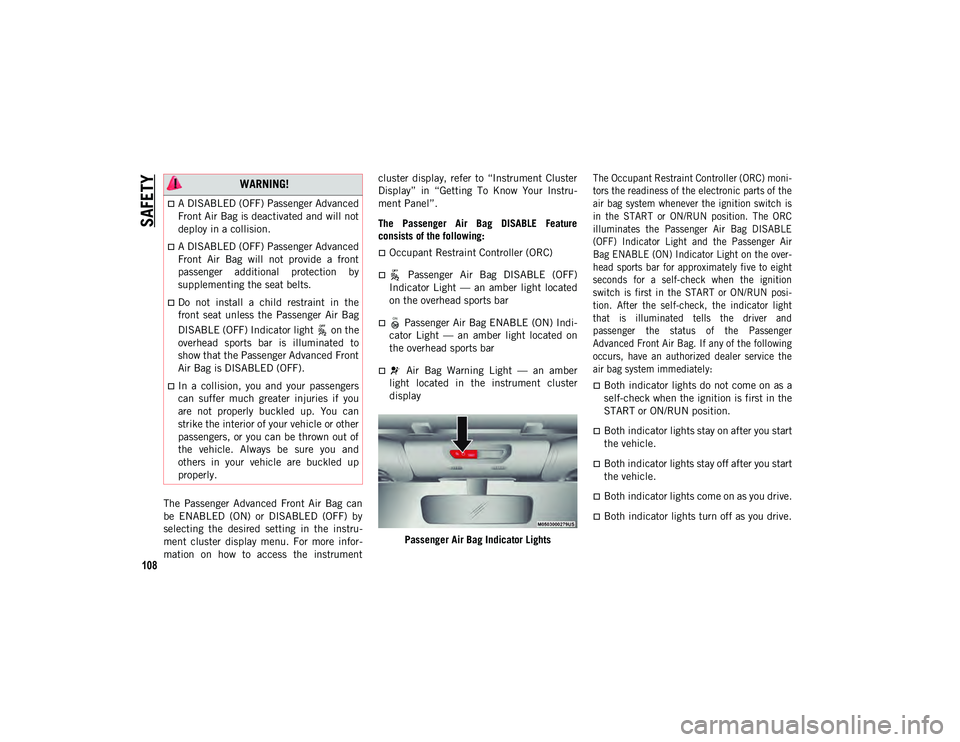
SAFETY
108
The Passenger Advanced Front Air Bag can
be ENABLED (ON) or DISABLED (OFF) by
selecting the desired setting in the instru-
ment cluster display menu. For more infor -
mation on how to access the instrument cluster display, refer to “Instrument Cluster
Display” in “Getting To Know Your Instru
-
ment Panel”.
The Passenger Air Bag DISABLE Feature
consists of the following:
Occupant Restraint Controller (ORC)
Passenger Air Bag DISABLE (OFF)
Indicator Light — an amber light located
on the overhead sports bar
Passenger Air Bag ENABLE (ON) Indi -
cator Light — an amber light located on
the overhead sports bar
Air Bag Warning Light — an amber
light located in the instrument cluster
display
Passenger Air Bag Indicator Lights
The Occupant Restraint Controller (ORC) moni
-
tors the readiness of the electronic parts of the
air bag system whenever the ignition switch is
in the START or ON/RUN position. The ORC
illuminates the Passenger Air Bag DISABLE
(OFF) Indicator Light and the Passenger Air
Bag ENABLE (ON) Indicator Light on the over -
head sports bar for approximately five to eight
seconds for a self-check when the ignition
switch is first in the START or ON/RUN posi -
tion. After the self-check, the indicator light
that is illuminated tells the driver and
passenger the status of the Passenger
Advanced Front Air Bag. If any of the following
occurs, have an authorized dealer service the
air bag system immediately:
Both indicator lights do not come on as a
self-check when the ignition is first in the
START or ON/RUN position.
Both indicator lights stay on after you start
the vehicle.
Both indicator lights stay off after you start
the vehicle.
Both indicator lights come on as you drive.
Both indicator lights turn off as you drive.
WARNING!
A DISABLED (OFF) Passenger Advanced
Front Air Bag is deactivated and will not
deploy in a collision.
A DISABLED (OFF) Passenger Advanced
Front Air Bag will not provide a front
passenger additional protection by
supplementing the seat belts.
Do not install a child restraint in the
front seat unless the Passenger Air Bag
DISABLE (OFF) Indicator light on the
overhead sports bar is illuminated to
show that the Passenger Advanced Front
Air Bag is DISABLED (OFF).
In a collision, you and your passengers
can suffer much greater injuries if you
are not properly buckled up. You can
strike the interior of your vehicle or other
passengers, or you can be thrown out of
the vehicle. Always be sure you and
others in your vehicle are buckled up
properly.
2020_JEEP_JL_WRANGLER_UG_RHD_UK.book Page 108
Page 118 of 330
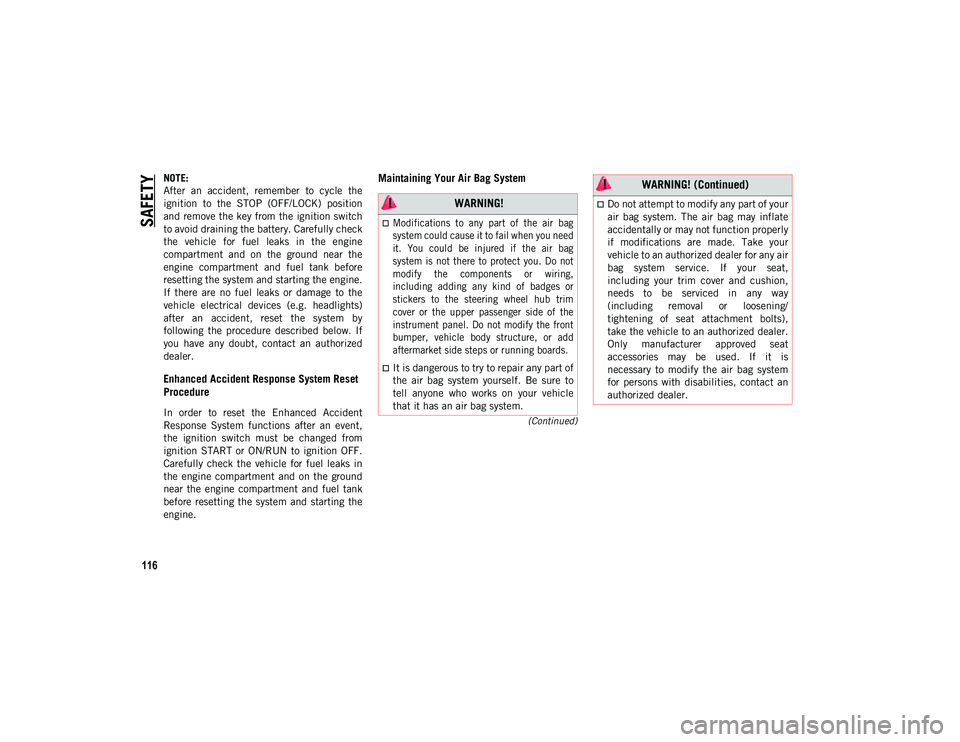
SAFETY
116
(Continued)
NOTE:
After an accident, remember to cycle the
ignition to the STOP (OFF/LOCK) position
and remove the key from the ignition switch
to avoid draining the battery. Carefully check
the vehicle for fuel leaks in the engine
compartment and on the ground near the
engine compartment and fuel tank before
resetting the system and starting the engine.
If there are no fuel leaks or damage to the
vehicle electrical devices (e.g. headlights)
after an accident, reset the system by
following the procedure described below. If
you have any doubt, contact an authorized
dealer.
Enhanced Accident Response System Reset
Procedure
In order to reset the Enhanced Accident
Response System functions after an event,
the ignition switch must be changed from
ignition START or ON/RUN to ignition OFF.
Carefully check the vehicle for fuel leaks in
the engine compartment and on the ground
near the engine compartment and fuel tank
before resetting the system and starting the
engine.
Maintaining Your Air Bag System
WARNING!
Modifications to any part of the air bag
system could cause it to fail when you need
it. You could be injured if the air bag
system is not there to protect you. Do not
modify the components or wiring,
including adding any kind of badges or
stickers to the steering wheel hub trim
cover or the upper passenger side of the
instrument panel. Do not modify the front
bumper, vehicle body structure, or add
aftermarket side steps or running boards.
It is dangerous to try to repair any part of
the air bag system yourself. Be sure to
tell anyone who works on your vehicle
that it has an air bag system.
Do not attempt to modify any part of your
air bag system. The air bag may inflate
accidentally or may not function properly
if modifications are made. Take your
vehicle to an authorized dealer for any air
bag system service. If your seat,
including your trim cover and cushion,
needs to be serviced in any way
(including removal or loosening/
tightening of seat attachment bolts),
take the vehicle to an authorized dealer.
Only manufacturer approved seat
accessories may be used. If it is
necessary to modify the air bag system
for persons with disabilities, contact an
authorized dealer.
WARNING! (Continued)
2020_JEEP_JL_WRANGLER_UG_RHD_UK.book Page 116
Page 138 of 330
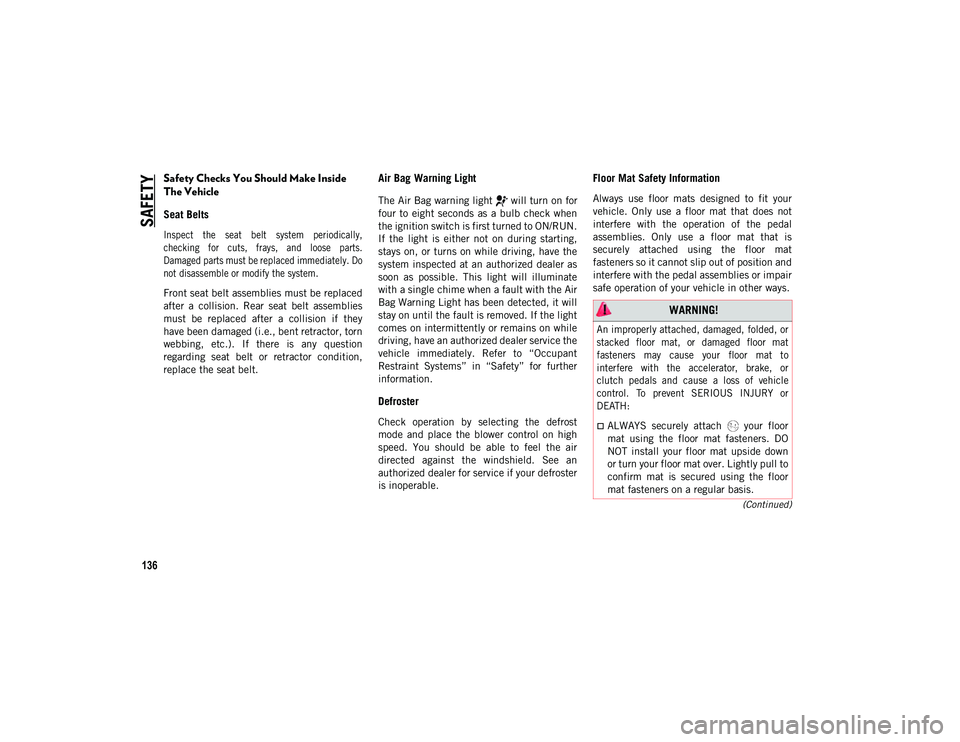
SAFETY
136
(Continued)
Safety Checks You Should Make Inside
The Vehicle
Seat Belts
Inspect the seat belt system periodically,
checking for cuts, frays, and loose parts.
Damaged parts must be replaced immediately. Do
not disassemble or modify the system.
Front seat belt assemblies must be replaced
after a collision. Rear seat belt assemblies
must be replaced after a collision if they
have been damaged (i.e., bent retractor, torn
webbing, etc.). If there is any question
regarding seat belt or retractor condition,
replace the seat belt.
Air Bag Warning Light
The Air Bag warning light will turn on for
four to eight seconds as a bulb check when
the ignition switch is first turned to ON/RUN.
If the light is either not on during starting,
stays on, or turns on while driving, have the
system inspected at an authorized dealer as
soon as possible. This light will illuminate
with a single chime when a fault with the Air
Bag Warning Light has been detected, it will
stay on until the fault is removed. If the light
comes on intermittently or remains on while
driving, have an authorized dealer service the
vehicle immediately. Refer to “Occupant
Restraint Systems” in “Safety” for further
information.
Defroster
Check operation by selecting the defrost
mode and place the blower control on high
speed. You should be able to feel the air
directed against the windshield. See an
authorized dealer for service if your defroster
is inoperable.
Floor Mat Safety Information
Always use floor mats designed to fit your
vehicle. Only use a floor mat that does not
interfere with the operation of the pedal
assemblies. Only use a floor mat that is
securely attached using the floor mat
fasteners so it cannot slip out of position and
interfere with the pedal assemblies or impair
safe operation of your vehicle in other ways.
WARNING!
An improperly attached, damaged, folded, or
stacked floor mat, or damaged floor mat
fasteners may cause your floor mat to
interfere with the accelerator, brake, or
clutch pedals and cause a loss of vehicle
control. To prevent SERIOUS INJURY or
DEATH:
ALWAYS securely attach your floor
mat using the floor mat fasteners. DO
NOT install your floor mat upside down
or turn your floor mat over. Lightly pull to
confirm mat is secured using the floor
mat fasteners on a regular basis.
2020_JEEP_JL_WRANGLER_UG_RHD_UK.book Page 136
Page 140 of 330
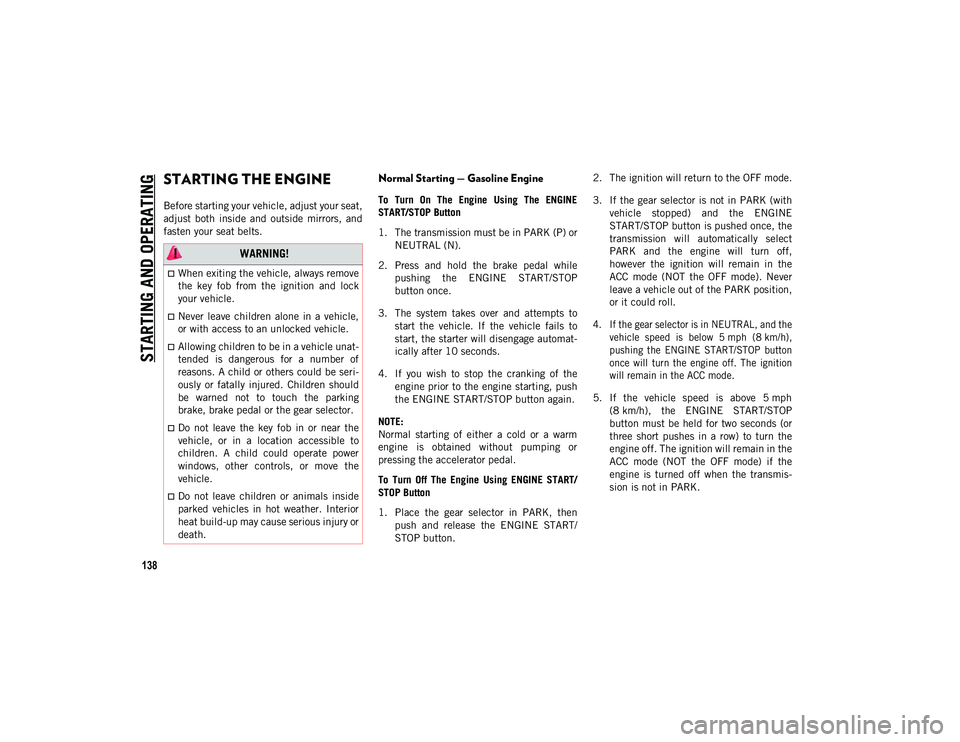
138
STARTING AND OPERATING
STARTING THE ENGINE
Before starting your vehicle, adjust your seat,
adjust both inside and outside mirrors, and
fasten your seat belts.
Normal Starting — Gasoline Engine
To Turn On The Engine Using The ENGINE
START/STOP Button
1. The transmission must be in PARK (P) orNEUTRAL (N).
2. Press and hold the brake pedal while pushing the ENGINE START/STOP
button once.
3. The system takes over and attempts to start the vehicle. If the vehicle fails to
start, the starter will disengage automat -
ically after 10 seconds.
4. If you wish to stop the cranking of the engine prior to the engine starting, push
the ENGINE START/STOP button again.
NOTE:
Normal starting of either a cold or a warm
engine is obtained without pumping or
pressing the accelerator pedal.
To Turn Off The Engine Using ENGINE START/
STOP Button
1. Place the gear selector in PARK, then push and release the ENGINE START/
STOP button. 2. The ignition will return to the OFF mode.
3. If the gear selector is not in PARK (with
vehicle stopped) and the ENGINE
START/STOP button is pushed once, the
transmission will automatically select
PARK and the engine will turn off,
however the ignition will remain in the
ACC mode (NOT the OFF mode). Never
leave a vehicle out of the PARK position,
or it could roll.
4. If the gear selector is in NEUTRAL, and the vehicle speed is below 5 mph (8 km/h),
pushing the ENGINE START/STOP button
once will turn the engine off. The ignition
will remain in the ACC mode.
5. If the vehicle speed is above 5 mph (8 km/h), the ENGINE START/STOP
button must be held for two seconds (or
three short pushes in a row) to turn the
engine off. The ignition will remain in the
ACC mode (NOT the OFF mode) if the
engine is turned off when the transmis -
sion is not in PARK.
WARNING!
When exiting the vehicle, always remove
the key fob from the ignition and lock
your vehicle.
Never leave children alone in a vehicle,
or with access to an unlocked vehicle.
Allowing children to be in a vehicle unat -
tended is dangerous for a number of
reasons. A child or others could be seri -
ously or fatally injured. Children should
be warned not to touch the parking
brake, brake pedal or the gear selector.
Do not leave the key fob in or near the
vehicle, or in a location accessible to
children. A child could operate power
windows, other controls, or move the
vehicle.
Do not leave children or animals inside
parked vehicles in hot weather. Interior
heat build-up may cause serious injury or
death.
2020_JEEP_JL_WRANGLER_UG_RHD_UK.book Page 138
Page 141 of 330
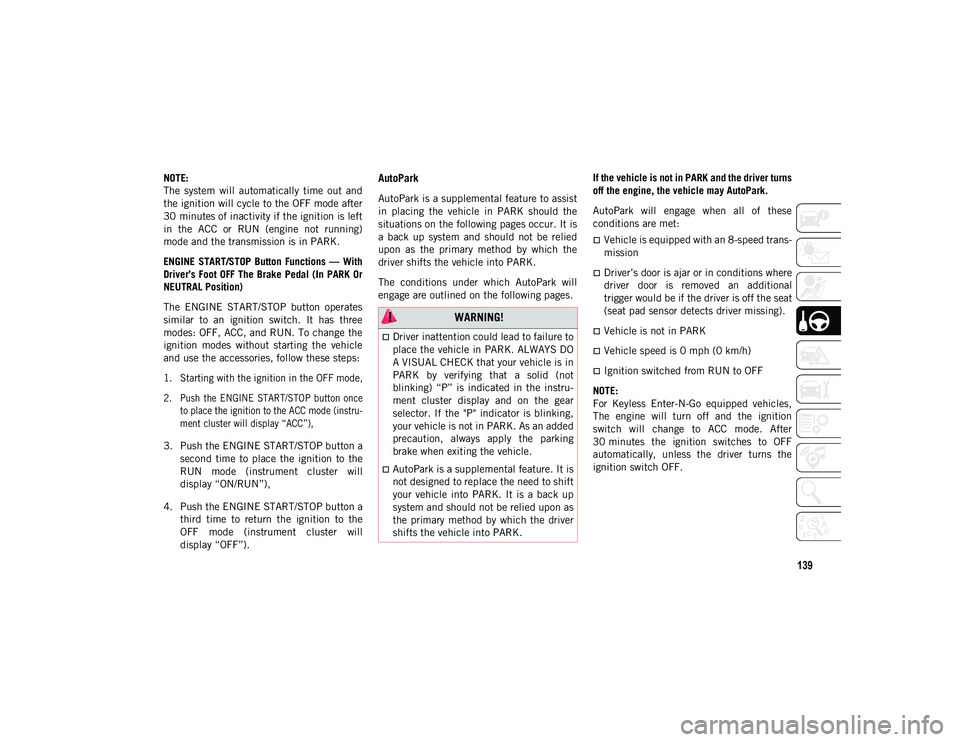
139
NOTE:
The system will automatically time out and
the ignition will cycle to the OFF mode after
30 minutes of inactivity if the ignition is left
in the ACC or RUN (engine not running)
mode and the transmission is in PARK.
ENGINE START/STOP Button Functions — With
Driver’s Foot OFF The Brake Pedal (In PARK Or
NEUTRAL Position)
The ENGINE START/STOP button operates
similar to an ignition switch. It has three
modes: OFF, ACC, and RUN. To change the
ignition modes without starting the vehicle
and use the accessories, follow these steps:
1. Starting with the ignition in the OFF mode,
2. Push the ENGINE START/STOP button onceto place the ignition to the ACC mode (instru -
ment cluster will display “ACC”),
3. Push the ENGINE START/STOP button a second time to place the ignition to the
RUN mode (instrument cluster will
display “ON/RUN”),
4. Push the ENGINE START/STOP button a third time to return the ignition to the
OFF mode (instrument cluster will
display “OFF”).AutoPark
AutoPark is a supplemental feature to assist
in placing the vehicle in PARK should the
situations on the following pages occur. It is
a back up system and should not be relied
upon as the primary method by which the
driver shifts the vehicle into PARK.
The conditions under which AutoPark will
engage are outlined on the following pages. If the vehicle is not in PARK and the driver turns
off the engine, the vehicle may AutoPark.
AutoPark will engage when all of these
conditions are met:
Vehicle is equipped with an 8-speed trans-
mission
Driver’s door is ajar or in conditions where
driver door is removed an additional
trigger would be if the driver is off the seat
(seat pad sensor detects driver missing).
Vehicle is not in PARK
Vehicle speed is 0 mph (0 km/h)
Ignition switched from RUN to OFF
NOTE:
For Keyless Enter-N-Go equipped vehicles,
The engine will turn off and the ignition
switch will change to ACC mode. After
30 minutes the ignition switches to OFF
automatically, unless the driver turns the
ignition switch OFF.
WARNING!
Driver inattention could lead to failure to
place the vehicle in PARK. ALWAYS DO
A VISUAL CHECK that your vehicle is in
PARK by verifying that a solid (not
blinking) “P” is indicated in the instru -
ment cluster display and on the gear
selector. If the "P" indicator is blinking,
your vehicle is not in PARK. As an added
precaution, always apply the parking
brake when exiting the vehicle.
AutoPark is a supplemental feature. It is
not designed to replace the need to shift
your vehicle into PARK. It is a back up
system and should not be relied upon as
the primary method by which the driver
shifts the vehicle into PARK.
2020_JEEP_JL_WRANGLER_UG_RHD_UK.book Page 139
Page 143 of 330
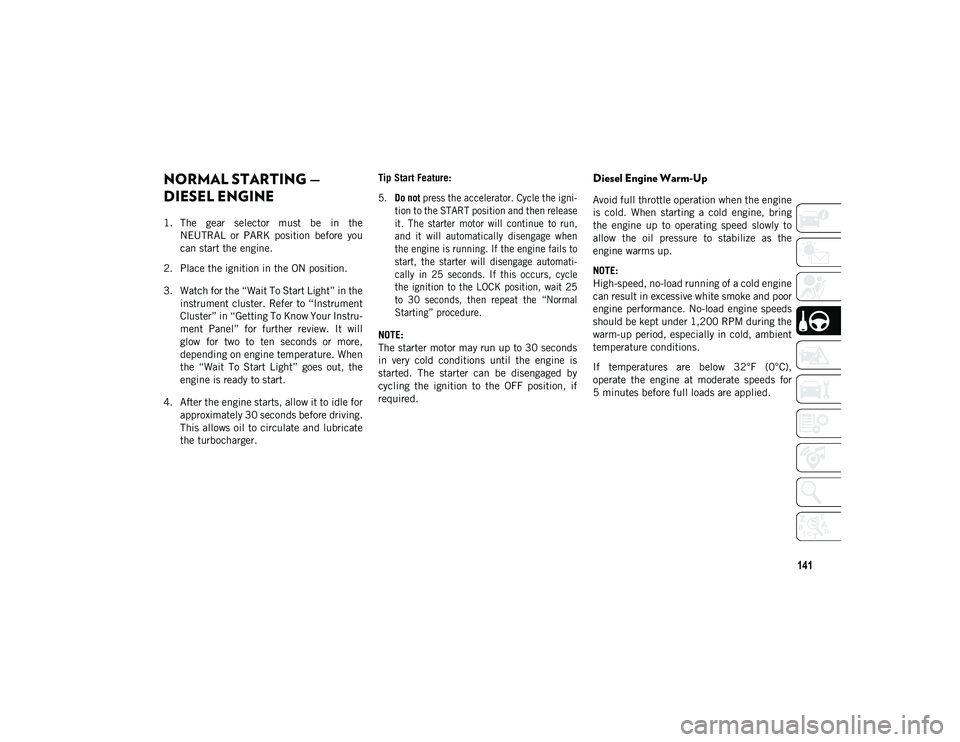
141
NORMAL STARTING —
DIESEL ENGINE
1. The gear selector must be in theNEUTRAL or PARK position before you
can start the engine.
2. Place the ignition in the ON position.
3. Watch for the “Wait To Start Light” in the instrument cluster. Refer to “Instrument
Cluster” in “Getting To Know Your Instru -
ment Panel” for further review. It will
glow for two to ten seconds or more,
depending on engine temperature. When
the “Wait To Start Light” goes out, the
engine is ready to start.
4. After the engine starts, allow it to idle for approximately 30 seconds before driving.
This allows oil to circulate and lubricate
the turbocharger. Tip Start Feature:
5.
Do not press the accelerator. Cycle the igni -
tion to the START position and then release
it. The starter motor will continue to run,
and it will automatically disengage when
the engine is running. If the engine fails to
start, the starter will disengage automati -
cally in 25 seconds. If this occurs, cycle
the ignition to the LOCK position, wait 25
to 30 seconds, then repeat the “Normal
Starting” procedure.
NOTE:
The starter motor may run up to 30 seconds
in very cold conditions until the engine is
started. The starter can be disengaged by
cycling the ignition to the OFF position, if
required.
Diesel Engine Warm-Up
Avoid full throttle operation when the engine
is cold. When starting a cold engine, bring
the engine up to operating speed slowly to
allow the oil pressure to stabilize as the
engine warms up.
NOTE:
High-speed, no-load running of a cold engine
can result in excessive white smoke and poor
engine performance. No-load engine speeds
should be kept under 1,200 RPM during the
warm-up period, especially in cold, ambient
temperature conditions.
If temperatures are below 32°F (0°C),
operate the engine at moderate speeds for
5 minutes before full loads are applied.
2020_JEEP_JL_WRANGLER_UG_RHD_UK.book Page 141
Page 146 of 330
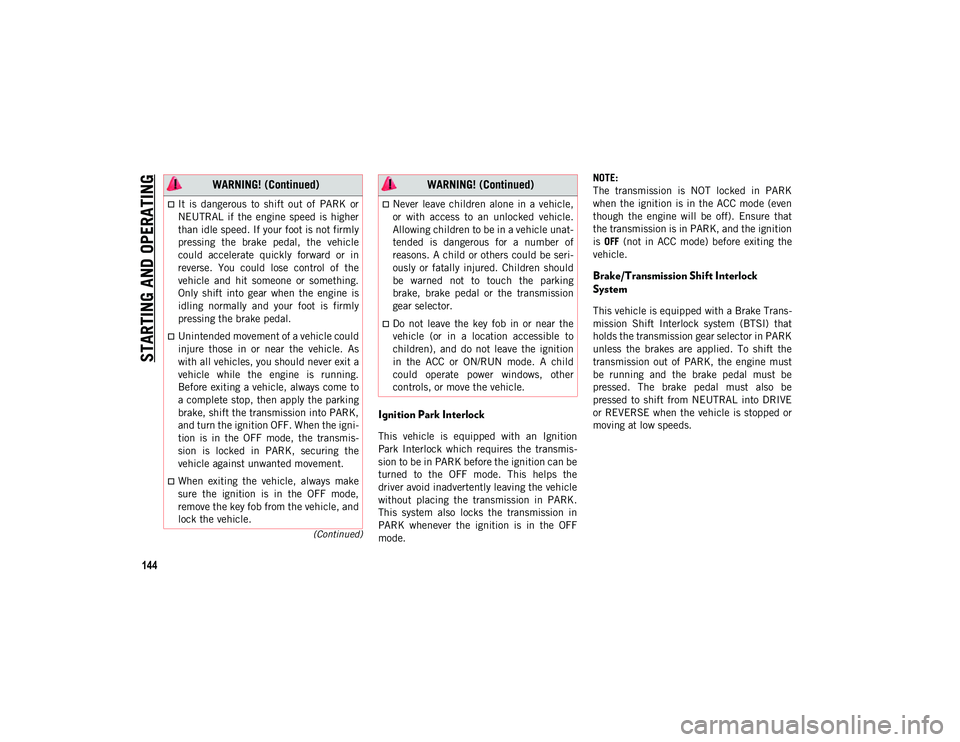
STARTING AND OPERATING
144
(Continued)
Ignition Park Interlock
This vehicle is equipped with an Ignition
Park Interlock which requires the transmis-
sion to be in PARK before the ignition can be
turned to the OFF mode. This helps the
driver avoid inadvertently leaving the vehicle
without placing the transmission in PARK.
This system also locks the transmission in
PARK whenever the ignition is in the OFF
mode. NOTE:
The transmission is NOT locked in PARK
when the ignition is in the ACC mode (even
though the engine will be off). Ensure that
the transmission is in PARK, and the ignition
is
OFF (not in ACC mode) before exiting the
vehicle.
Brake/Transmission Shift Interlock
System
This vehicle is equipped with a Brake Trans -
mission Shift Interlock system (BTSI) that
holds the transmission gear selector in PARK
unless the brakes are applied. To shift the
transmission out of PARK, the engine must
be running and the brake pedal must be
pressed. The brake pedal must also be
pressed to shift from NEUTRAL into DRIVE
or REVERSE when the vehicle is stopped or
moving at low speeds.
It is dangerous to shift out of PARK or
NEUTRAL if the engine speed is higher
than idle speed. If your foot is not firmly
pressing the brake pedal, the vehicle
could accelerate quickly forward or in
reverse. You could lose control of the
vehicle and hit someone or something.
Only shift into gear when the engine is
idling normally and your foot is firmly
pressing the brake pedal.
Unintended movement of a vehicle could
injure those in or near the vehicle. As
with all vehicles, you should never exit a
vehicle while the engine is running.
Before exiting a vehicle, always come to
a complete stop, then apply the parking
brake, shift the transmission into PARK,
and turn the ignition OFF. When the igni -
tion is in the OFF mode, the transmis-
sion is locked in PARK, securing the
vehicle against unwanted movement.
When exiting the vehicle, always make
sure the ignition is in the OFF mode,
remove the key fob from the vehicle, and
lock the vehicle.
WARNING! (Continued)
Never leave children alone in a vehicle,
or with access to an unlocked vehicle.
Allowing children to be in a vehicle unat -
tended is dangerous for a number of
reasons. A child or others could be seri -
ously or fatally injured. Children should
be warned not to touch the parking
brake, brake pedal or the transmission
gear selector.
Do not leave the key fob in or near the
vehicle (or in a location accessible to
children), and do not leave the ignition
in the ACC or ON/RUN mode. A child
could operate power windows, other
controls, or move the vehicle.
WARNING! (Continued)
2020_JEEP_JL_WRANGLER_UG_RHD_UK.book Page 144
Page 153 of 330
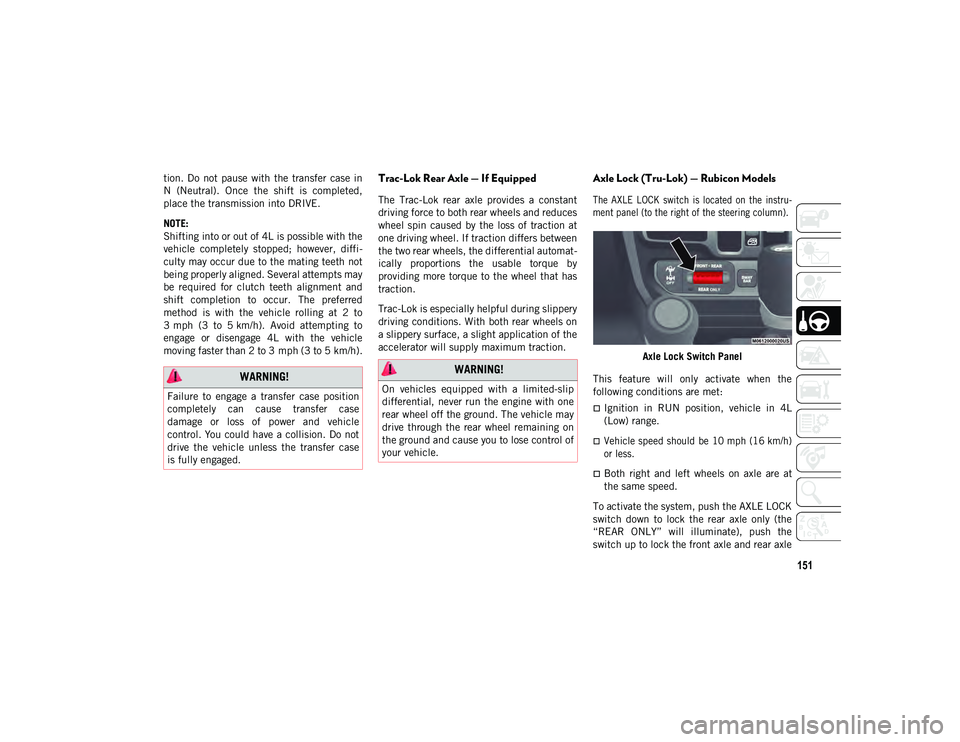
151
tion. Do not pause with the transfer case in
N (Neutral). Once the shift is completed,
place the transmission into DRIVE.
NOTE:
Shifting into or out of 4L is possible with the
vehicle completely stopped; however, diffi-
culty may occur due to the mating teeth not
being properly aligned. Several attempts may
be required for clutch teeth alignment and
shift completion to occur. The preferred
method is with the vehicle rolling at 2 to
3 mph (3 to 5 km/h). Avoid attempting to
engage or disengage 4L with the vehicle
moving faster than 2 to 3 mph (3 to 5 km/h).Trac-Lok Rear Axle — If Equipped
The Trac-Lok rear axle provides a constant
driving force to both rear wheels and reduces
wheel spin caused by the loss of traction at
one driving wheel. If traction differs between
the two rear wheels, the differential automat -
ically proportions the usable torque by
providing more torque to the wheel that has
traction.
Trac-Lok is especially helpful during slippery
driving conditions. With both rear wheels on
a slippery surface, a slight application of the
accelerator will supply maximum traction.
Axle Lock (Tru-Lok) — Rubicon Models
The AXLE LOCK switch is located on the instru -
ment panel (to the right of the steering column).
Axle Lock Switch Panel
This feature will only activate when the
following conditions are met:
Ignition in RUN position, vehicle in 4L
(Low) range.
Vehicle speed should be 10 mph (16 km/h)
or less.
Both right and left wheels on axle are at
the same speed.
To activate the system, push the AXLE LOCK
switch down to lock the rear axle only (the
“REAR ONLY” will illuminate), push the
switch up to lock the front axle and rear axle
WARNING!
Failure to engage a transfer case position
completely can cause transfer case
damage or loss of power and vehicle
control. You could have a collision. Do not
drive the vehicle unless the transfer case
is fully engaged.
WARNING!
On vehicles equipped with a limited-slip
differential, never run the engine with one
rear wheel off the ground. The vehicle may
drive through the rear wheel remaining on
the ground and cause you to lose control of
your vehicle.
2020_JEEP_JL_WRANGLER_UG_RHD_UK.book Page 151
Page 154 of 330
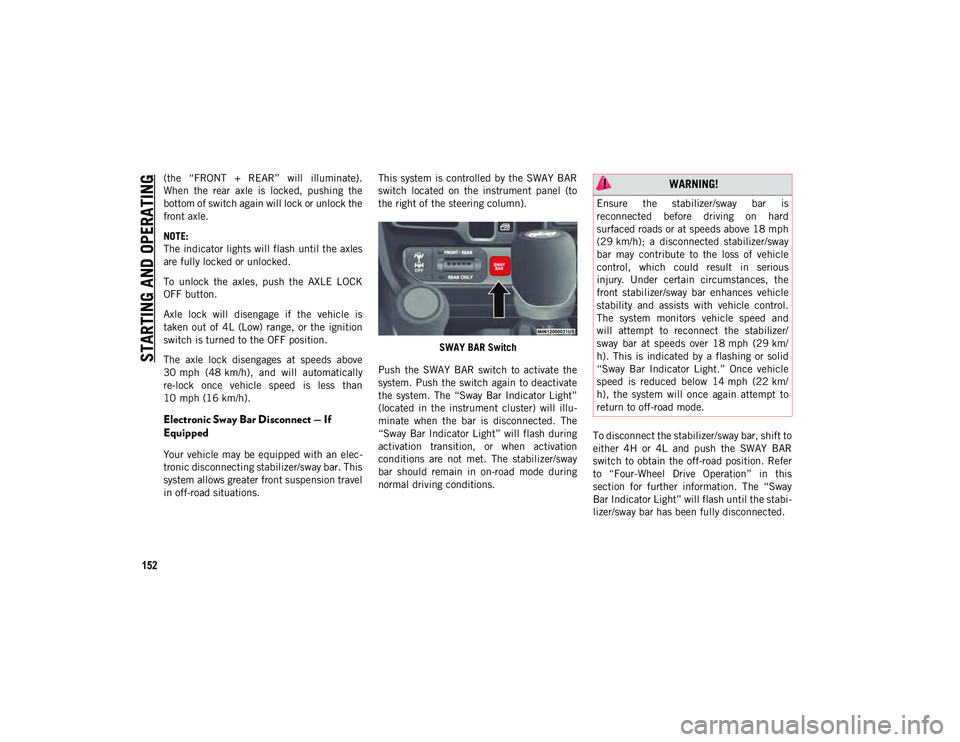
STARTING AND OPERATING
152
(the “FRONT + REAR” will illuminate).
When the rear axle is locked, pushing the
bottom of switch again will lock or unlock the
front axle.
NOTE:
The indicator lights will flash until the axles
are fully locked or unlocked.
To unlock the axles, push the AXLE LOCK
OFF button.
Axle lock will disengage if the vehicle is
taken out of 4L (Low) range, or the ignition
switch is turned to the OFF position.
The axle lock disengages at speeds above
30 mph (48 km/h), and will automaticallyre-lock once vehicle speed is less than
10 mph (16 km/h).
Electronic Sway Bar Disconnect — If
Equipped
Your vehicle may be equipped with an elec -
tronic disconnecting stabilizer/sway bar. This
system allows greater front suspension travel
in off-road situations. This system is controlled by the SWAY BAR
switch located on the instrument panel (to
the right of the steering column).
SWAY BAR Switch
Push the SWAY BAR switch to activate the
system. Push the switch again to deactivate
the system. The “Sway Bar Indicator Light”
(located in the instrument cluster) will illu -
minate when the bar is disconnected. The
“Sway Bar Indicator Light” will flash during
activation transition, or when activation
conditions are not met. The stabilizer/sway
bar should remain in on-road mode during
normal driving conditions. To disconnect the stabilizer/sway bar, shift to
either 4H or 4L and push the SWAY BAR
switch to obtain the off-road position. Refer
to “Four-Wheel Drive Operation” in this
section for further information. The “Sway
Bar Indicator Light” will flash until the stabi
-
lizer/sway bar has been fully disconnected.
WARNING!
Ensure the stabilizer/sway bar is
reconnected before driving on hard
surfaced roads or at speeds above 18 mph
(29 km/h); a disconnected stabilizer/sway
bar may contribute to the loss of vehicle
control, which could result in serious
injury. Under certain circumstances, the
front stabilizer/sway bar enhances vehicle
stability and assists with vehicle control.
The system monitors vehicle speed and
will attempt to reconnect the stabilizer/
sway bar at speeds over 18 mph (29 km/
h). This is indicated by a flashing or solid
“Sway Bar Indicator Light.” Once vehicle
speed is reduced below 14 mph (22 km/
h), the system will once again attempt to
return to off-road mode.
2020_JEEP_JL_WRANGLER_UG_RHD_UK.book Page 152